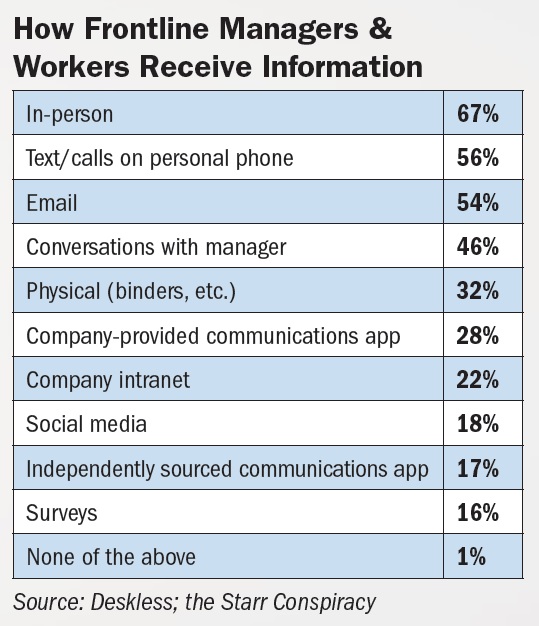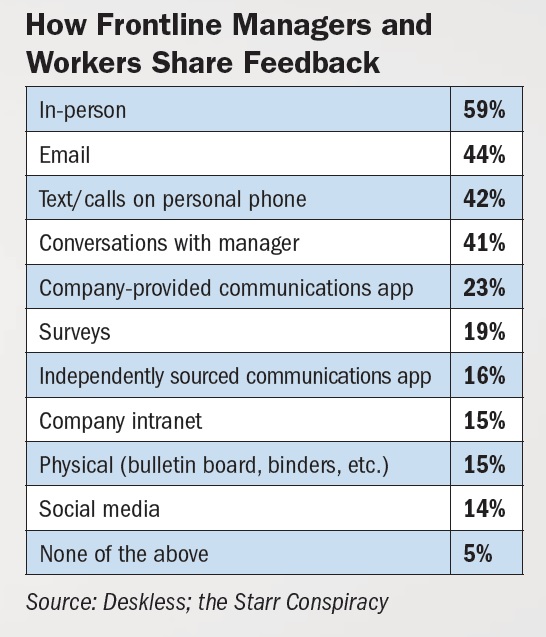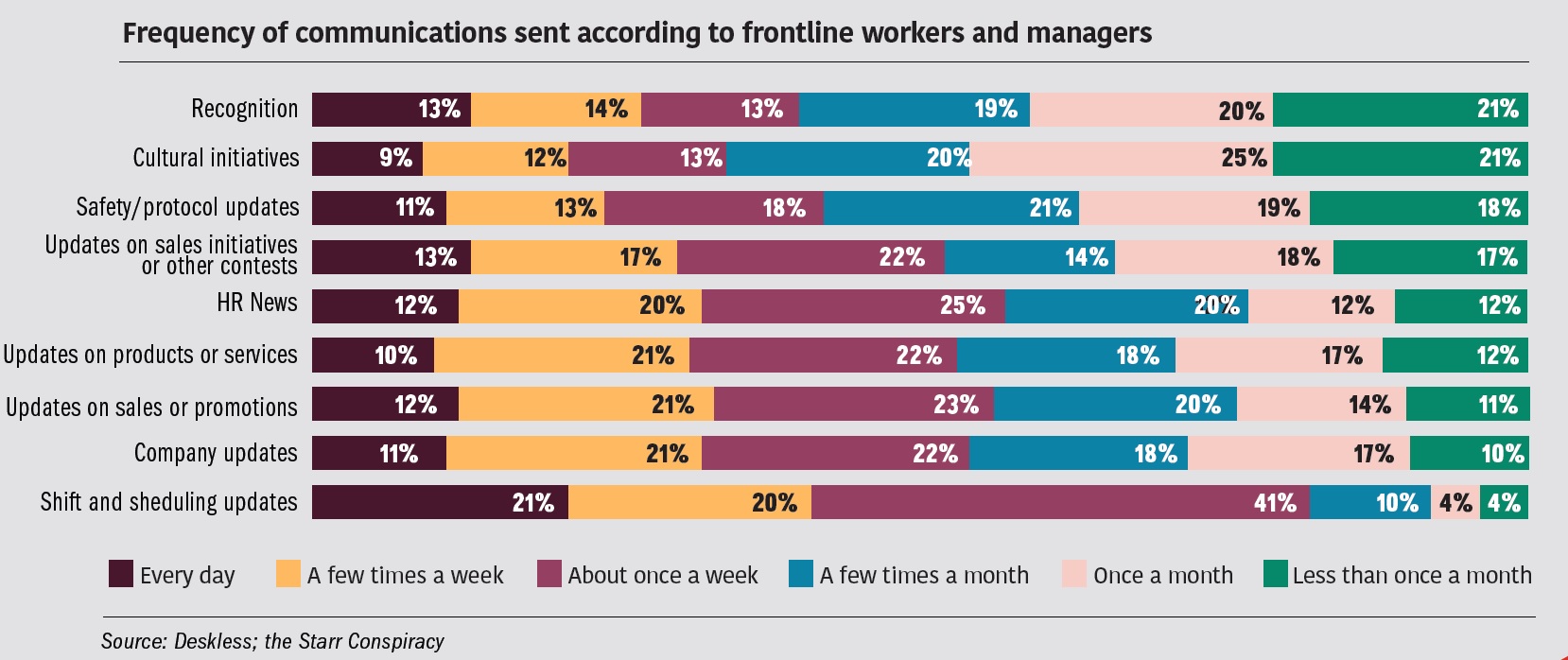Organizations that operate with large deskless workforces are suffering from a communications breakdown. Quite simply, they are in need of more robust and customized internal communications applications and services.
According to surveys and research sponsored by Deckless, a research hub and community of organizational leaders responsible for deskless and frontline employees, internal communications with deskless workforces are “fractured” and inefficient – often unidirectional, unmonitored, outdated and incapable of facilitating current objectives. Indeed, at a time when employee experience and training are top-of-mind among C-suite residents, executives and managers of organizations with large deskless workforces find themselves operating with limited or non-existent feedback loops and often guessing whether or not messaging is being heard.
And make no mistake; this is no small problem. More than 2.5 billion workers across the globe, in sectors such as healthcare, agriculture, construction, retail, distribution, manufacturing and transportation do not sit behind a desk to do their jobs, show data from investment firm Emergence. Deskless workers make up nearly 80 percent of all employees, and often these employees serve in customer-facing roles.
Yet these deskless, frontline workforces have largely been on the sidelines of digital transformation investments, witnessing significant investments in deskbound tools and technology while they continue to rely on clunky technology solutions or even manual or paper-based process to do their jobs. Too often, say researchers at Deckless, tools built for the office environment are “tweaked or reskinned, but the process remain deskbound by nature, purpose-built for workers in an office, at a desk, in front of a computer.”
After COVID-19 lockdowns hit the world, digital transformations schedules accelerated, as IT departments quickly pushed new cloud, connectivity and communications technology to the desks of newly remote and hybrid workforces. Meanwhile, the story was very different for the two-billion-plus deskless and frontline employees across the globe. According to Emergence’s survey of deskless workers, 65 percent were provided no additional technology during the pandemic.

This comes despite the fact that 75 percent of deskless workers report to spending most of their time using technology, and 70 percent believe access to new technology would help them do their jobs better. When deskless respondents were asked about the areas of their work lives that would benefit from technology, top responses included communications (96 percent), operations/logistics (93 percent), onboard/training (91 percent) and productivity boosts (90 percent).
In terms of communications functions specifically, deskless workers face “a dangerous concoction of ad-hoc channels and indirect cascades” said the Deskless study. Information is coming to workers through a range of channels and sources, including peers, direct managers, head offices and automated sources. Often digital information is shared informally from managers to workers, or vice versa, and more often than not it’s through personal channels not sanctioned nor monitored by the company. More than three-quarters of frontline respondents said they check their phone at work, whether or not it’s allowed.
The number one way that frontline managers and their deskless workforces receive digital company communications is through “text/calls on personal phone.” That method was second only to “in-person” interactions. Texts and calls on personal phones, along with email, also are top ways that managers and workers provide feedback to business leaders.
Overall, information is more likely to be disseminated by physical binders and bulletin boards than by a company-provided communications app. Nearly one in five deskless workers sources their own communications app. Automated communications currently is reaching only about one in five deskless workers.

“The reality is that frontline workers are filling the communications gap, at least to the frontline manager, by using their personal devices – because they are lacking a company-sponsored alternative,” warned the report.
In other words, the bulk of information that deskless workers receive comes through systems that don’t allow for the standardization, optimization and tracking typically required for large-scale workforces, said Deskless researchers. In turn, managers are left wondering if messages are being received, while corporate leaders are left wondering if what’s bubbling up from managers is an accurate picture of what’s on the ground.
“We try to email, but 60 percent of people don’t check it,” said a responding operations and logistics manager of a manufacturing company. “We run 24/7, but we don’t have time built in to do communication meetings. All meetings are voluntary and happen during breaks. To know people read and understand the things we post is very difficult.”
Another manager described internal communications with deskless workforces as “sending information into the abyss.”
As might be expected, what is being sent out isn’t happening very frequently. The only communications type regularly shared on a daily basis are mission-critical shift and scheduling updates, showed Deskless’ data. All other communications types were more commonly shared once a week or, in the case of recognition and cultural initiatives, once a month or less.

There also may be an inordinate amount of faith being put into frontline managers to report back what’s actually happening on the ground. According to the data from Deskless, frontline workers largely rely on managers for receiving company communications. Certainly, direct communications between deskless workforces and frontline managers will always be important, but managers are being asked to decipher and disseminate what could be a cascade of in-person conversations, calls, text, emails and automated responses.
Not surprisingly, as the primary contact between frontline employees and corporate leaders, frontline managers reported difficulty in finding enough time to surface feedback and source answers to questions and other necessary information. When they do have enough time, ill-suited or outdated communications, feedback, training and execution systems ae forcing them to shoulder a heavy load acting as the intermediary between corporate and staff, said Deskless researchers.
“They’re trying to bubble up feedback and employee insights while also communicating crucial information back to their staff and implementing cultural, product and promotional initiatives – all while simply trying to stay afloat on a day-to-day basis,” the Deskless report exclaimed.
As such, some disconnects between what workers say and what corporate leaders hear are to be expected, and when asked on a scale of 1 to 10 how effective their organization’s communication is, 65 percent of corporate leaders scored their communications an 8 or higher, while only 35 percent of workers did the same.
A disconnect also was discovered when talking about investing in technology, showed the Deskless data. When asked whether they agreed with the statement, “I believe my organization invests in new technologies for frontline workers,” 73 percent of corporate respondents strongly or somewhat agree, while only 39 percent of frontline workers feel the same. In fact, managers have reported that low-tech analog solutions, such as whiteboards and binders, not only are still being used but are still being actively adopted and encouraged. Likewise, just 4 percent of corporate leaders say the availability of training and upskilling for frontline employees is inadequate, while about 30 percent of frontline employees see them as inadequate.
The EX Breakdown
Considering the large deskless workforces that frontline organizations employ, there’s a wealth of information that can be used to fine-tune messaging, improve task and campaign execution and even predict turnover, argued researchers at Deskless. “There’s also a massive opportunity to tap into the frontline perspective on the insights they’re communicating, which can lead to continuous improvement and improved business outcomes,” said the research firm.
The largely “top-down” approach to communications, typically shoehorned from the desked world into deskless environments, along with the mostly unstructured feedback loops are limiting organizations’ abilities to tap into these resources or ensure that insights and feedback are finding their way to the right people.
“Furthermore, there’s a concern among managers about the results of the feedback they share,” said the Deskless report. “The large, sweeping initiatives that are implemented and shared back down to frontlines feel misaligned against the original feedback or concerns, and managers feel like corporate is out of touch with the ‘day-to-day chaos’ of the frontline experience.”
Nearly 40 percent of frontline respondents said that fractured communication was very or extremely challenging to their day-to-day work.
An infusion of communications technology, meanwhile, can consolidate channels to allow for one fluid, company sanctioned channel for information to flow down – and back up, Deskless researchers pointed out. Communications applications can embrace the ad-hoc, in-the-moment communications, harnessed into a more consistent and scaled-up approach, reducing the load on managers and opening up opportunities for continuous feedback loops in one place, they continued.
“This allows for organizations to scale up communications, delivering information to the frontline more directly, with the analytics in place to measure effectiveness and knowledge retention companywide,” concluded the research report.
The good news is, there is general consensus among all participants that technology investments can help alleviate existing challenges. According to the survey of deskless organizations, 84 percent of corporate leaders, 78 percent of frontline managers and 69 percent of deskless workers believe that investing in new technologies for frontline workers can improve the overall success of their organizations.









